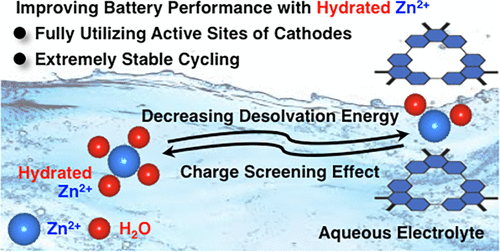当前位置:
X-MOL 学术
›
J. Am. Chem. Soc.
›
论文详情
Our official English website, www.x-mol.net, welcomes your
feedback! (Note: you will need to create a separate account there.)
Redox-Active Phenanthrenequinone Triangles in Aqueous Rechargeable Zinc Batteries
Journal of the American Chemical Society ( IF 14.4 ) Pub Date : 2020-01-02 , DOI: 10.1021/jacs.9b12436 Kwan Woo Nam 1 , Heejin Kim 2 , Yassine Beldjoudi 1 , Tae-Woo Kwon 1 , Dong Jun Kim 3 , J Fraser Stoddart 1, 3, 4
Journal of the American Chemical Society ( IF 14.4 ) Pub Date : 2020-01-02 , DOI: 10.1021/jacs.9b12436 Kwan Woo Nam 1 , Heejin Kim 2 , Yassine Beldjoudi 1 , Tae-Woo Kwon 1 , Dong Jun Kim 3 , J Fraser Stoddart 1, 3, 4
Affiliation

|
Aqueous rechargeable zinc batteries (ZBs) have received considerable attention recently for large-scale energy storage systems in terms of rate performance, cost, and safety. Nevertheless, these ZBs still remain a subject for investigation, as researchers search for cathode materials enabling high performance. Among the various candidate cathode materials for ZBs, quinone compounds stand out as candidates because of their high specific capacity, sustainability, and low cost. The quinone-based cathodes, however, suffer from the critical limitation of undergoing dissolution during battery cycling, leading to a deterioration in battery life. In order to address this problem, we have introduced a redox-active triangular phenanthrenequinone-based macrocycle (PQ-Δ) with a rigid geometry and layered superstructure. Notably, we have confirmed that Zn2+ ions, together with H2O molecules, can be inserted into the PQ-Δ organic cathode, and, as a consequence, the interfacial resistance between the cathode and electrolytes is decreased effectively. Density
functional theory calculations have revealed that the low interfacial resistance can be attributed mainly to decreasing the desolvation energy penalty as a result of the insertion of hydrated Zn2+ ions in the PQ-Δ cathode. The combined effects of the insertion of hydrated Zn2+ ions and the robust triangular structure of PQ-Δ serves to achieve a large reversible capacity of 210 mAh g-1 at a high current density of 150 mA g-1, along with an excellent cycle-life, i.e., 99.9% retention after 500 cycles. These findings suggest that the utilization of electron-active organic macrocycles, combined with the low interfacial resistance associated with the solvation of divalent carrier ions, is essential for the overall performance of divalent battery systems.
中文翻译:

水性可充电锌电池中的氧化还原活性菲醌三角形
最近,在倍率性能、成本和安全性方面,水性可充电锌电池 (ZB) 在大规模储能系统中受到了相当大的关注。尽管如此,这些 ZB 仍然是一个有待研究的主题,因为研究人员正在寻找能够实现高性能的正极材料。在 ZB 的各种候选正极材料中,醌化合物因其高比容量、可持续性和低成本而成为候选材料。然而,基于醌的正极在电池循环过程中受到溶解的严重限制,导致电池寿命缩短。为了解决这个问题,我们引入了一种具有刚性几何形状和分层上层结构的氧化还原活性三角菲醌基大环(PQ-Δ)。尤其,我们已经证实 Zn2+ 离子与 H2O 分子一起可以插入 PQ-Δ 有机正极,从而有效降低正极和电解质之间的界面电阻。密度泛函理论计算表明,低界面电阻主要归因于水合 Zn2+ 离子插入 PQ-Δ 阴极导致去溶剂化能量损失降低。水合 Zn2+ 离子的插入和 PQ-Δ 坚固的三角形结构的综合作用有助于在 150 mA g-1 的高电流密度下实现 210 mAh g-1 的大可逆容量,以及出色的循环-寿命,即 500 次循环后保持 99.9%。这些发现表明,利用电子活性有机大环,
更新日期:2020-01-02
中文翻译:

水性可充电锌电池中的氧化还原活性菲醌三角形
最近,在倍率性能、成本和安全性方面,水性可充电锌电池 (ZB) 在大规模储能系统中受到了相当大的关注。尽管如此,这些 ZB 仍然是一个有待研究的主题,因为研究人员正在寻找能够实现高性能的正极材料。在 ZB 的各种候选正极材料中,醌化合物因其高比容量、可持续性和低成本而成为候选材料。然而,基于醌的正极在电池循环过程中受到溶解的严重限制,导致电池寿命缩短。为了解决这个问题,我们引入了一种具有刚性几何形状和分层上层结构的氧化还原活性三角菲醌基大环(PQ-Δ)。尤其,我们已经证实 Zn2+ 离子与 H2O 分子一起可以插入 PQ-Δ 有机正极,从而有效降低正极和电解质之间的界面电阻。密度泛函理论计算表明,低界面电阻主要归因于水合 Zn2+ 离子插入 PQ-Δ 阴极导致去溶剂化能量损失降低。水合 Zn2+ 离子的插入和 PQ-Δ 坚固的三角形结构的综合作用有助于在 150 mA g-1 的高电流密度下实现 210 mAh g-1 的大可逆容量,以及出色的循环-寿命,即 500 次循环后保持 99.9%。这些发现表明,利用电子活性有机大环,









































 京公网安备 11010802027423号
京公网安备 11010802027423号